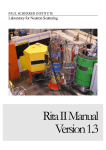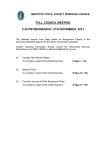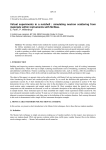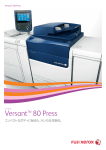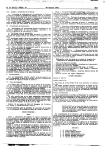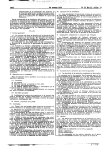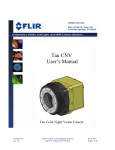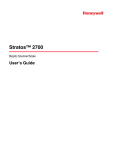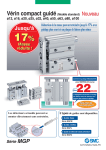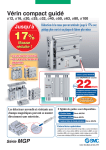Download USER GUIDE HRPT: - Paul Scherrer Institute
Transcript
USER GUIDE HRPT:
HIGH RESOLUTION POWDER
DIFFRACTOMETER FOR THERMAL NEUTRONS
AT THE SINQ TARGET STATION
Sector 41
Caution: Sensitive detector - Avoid shocks/vibrations !
(Do not place auxiliary equipment onto the detector shielding !)
version September 2002
A) GENERAL PROPERTIES AND PARAMETERS
p.
A1.
A2.
A3.
A4.
A5.
A6.
A7.
A8.
A9.
A10.
A11.
A12.
3
5
5
11
11
11
11
12
13
15
15
17
Instrument design
Polychromatic neutron beam
Monochromators
Secondary collimation
Sample, sample table, beam stop
Detector bank
Multidetector and effective collimation
Detector electronics
Resolution Functions
Standard samples
Examples of powder measurements and profile refinements
References
B) HRPT COMPUTER CONTROL
18
How to…
B1. log into the HRPT computer
B2. start the instrument control program SICS
B3. start the powderstatus display
B4. start a measurement on HRPT: the SICS commands
B5. edit the command file
B6. perform scans
B7. add, subtract and transform data files
B8. view data files
B9. use PC and Mac terminals of HRPT
18
18
19
22
24
24
25
26
26
Appendix
B10. Data evaluation, profile refinement, plots
B11. Unix and further SICS commands
B12. Troubleshooting
B13. Summary of HRPT motors
B14. Check list HRPT
B15 Contact persons
27
30
30
31
32
33
C) SAFETY PROCEDURE AT SINQ
34
2
A) GENERAL PROPERTIES AND PARAMETERS
A1. Instrument design
Fig. 1a: HRPT concept
Complementary to DMC, the multidetector diffractometer HRPT is designed as flexible instrument
for efficient neutron powder diffraction studies - also for small sample sizes. High resolution is
achieved by thermal neutrons, large scattering angles of the monochromator and of the sample (up
to 165°). By means of primary collimators, a secondary slit system and by appropriate choice of the
3
sample diameter, resolution and intensity may be optimised. Due to the use of a large position
sensitive (PSD) 3He detector, simultaneous measurements are possible within a scattering angle
range of 159.9° with angular step 0.1 degree (e.g. for real-time experiments). Depending on the
desired point density and resolution up to dd /d < (0.002, 0.001) [in the high intensity (HI) and high
resolution (HR) modes of operation, respectively for monochromator take-off-angle 2qM = 120°; d =
interplanar spacing], the detector may be positioned on air cushions also at intermediate positions.
Standard measurements are performed by means of an evacuated aluminium pot equipped with a
cooling machine, which can be oscillated to reduce preferred orientation effects of the sample. An
oscillating radial collimator suppresses Bragg peaks from the sample environment such as for
cryostats or furnaces. The instrument is controlled via the SICS software (clients written in JAVA,
TCP/IP network, http://lns00.psi.ch) of PSI by an UNIX work station, permitting rapid online
refinements. The data transfer from the fast Cerca electronics (developed by E. Berruyer) to a PSI
user interface and histogram memory (developped by N. Schlumpf et al.) is made via a central PC
data exchange system and optical cables. More instrumental details may be found in the references
[1,2].
Complementary to synchrotron X-ray powder diffraction studies, the applications of HRPT are
high-resolution refinements of chemical and magnetic structures as well as phase analysis of novel
materials. Because of the generally weak absorption, neutrons yield information on bulk properties
(average over large sample volumes) and permit in a nondestructive way the detection of lattice
distortions, defects and internal microstrains. Also real-time (insitu) investigations of chemical or
structural changes and of magnetic phase transitions in crystalline, quasicrystalline, amorphous and
liquid samples including technically interesting new materials are possible. Examples are precise
localization of light elements (isotopes) such as hydrogen (deuterium) in metal deuterides (metal
hydrogen storage systems) or zeolites, oxygen in high-Tc and CMR systems and other ceramics or
7
Li in ionic conductors etc. Another advantage may be the distinction between neighbouring
elements in the periodic table such as Mn (negative neutron scattering amplitude b) and Fe (b > 0).
Moreover, nuclear neutron scattering yields in case of a sufficienty large range of momentum
transfer accurate information on average thermal motion (harmonic and anharmonic temperature
factors). These applications are important in crystallography, condensed matter physics, chemistry
and material science. In particular, profile analysis as a function of external parameters such as
temperature (e.g. 10 K - 300 K with CTI cooling machines) is standard in neutron diffraction.
Accessible temperature range: 120 mK – 1300 K,
vertical magnetic field up to 4 T,
hydrostatic pressure up to 8 kbar (Ti-Zr zero matrix pressure cell).
4
Fig. 1b: Instrument views at SINQ target station. Picture on the right: Evacuated Al pot with
oscillating closed-cycle He refrigerator. Oscillation may reduce preferred orientation effects.
A2. Polychromatic neutron beam
Thermal neutron beam R41 from H2O scatterer close to the target
Primary beam width: 58, 44 or 29 mm (+ beam closed), beam height
150 mm within the plug
PRIMARY COLLIMATION:
Al alloy-Gd-O Soller collimators with
1. a1 = 6', 12' (high resolution),
ª 40', high intensity)
2. a1 = - (ª
Si FILTER:
Length 20 cm, liquid N2 cooled,
check temperature
EVACUATED BEAM TUBE:
Between Si filter and monochromator,
vacuum to be checked
Fig. 2: HRPT monochromator lift.
A3. Monochromators
qM: 90° or 120°
MONOCHROMATOR SCATTERING ANGLES 2q
MONOCHROMATOR 1 (lower lift position):
Ge (hkk), wafer type, vertically focusing (for w not very different from 0, -> intensity gain up
to a factor of 4, curvature variable), see Figs. 3 and 4
5
Planes (511) parallel to the monochromator surface plane. Other (hkk) planes may be used by
slight rotation (angle w ) of the monochromator around the vertical axis coinciding with a
[01 1 ] axis of the monochromator, see table 1. Due to the nonzero structure factor of Ge reflections
(2h2k2l) for even indices (hkl) higher order contamination l/2 is more likely than in case of odd
(hkl), but the intensity may be higher !
Table 1: Possible choice of neutron wavelength l [Å].
Ge
qM = 120°
2qM = 90°
2q
w M511 [°] lcal.
lobs..
lobs..
lcal.
10-6I(nmon.)/(h,
1250mA)
$
311
-9.45 2.413
2.410* 0.79
2.955
2.953*
1.5
3.3
400
15.79 2.000
0.75
2.450
2.449*# 0.8
2.8
$
133
-60.94 1.836
1.832 0.73
2.248
2.246*
0.5
1.0
511
0.00 1.540
1.539(1) 0.68
1.886
1.886
4.6
6.3
533
-24.52 1.220
1.219 0.61
1.495
1.494
4.1
5.1
711
4.37 1.121
0.58
1.372
1.372
3.3
3.5
733
-15.43 0.978
0.54
1.197
1.197
2.8
2.7
822
3.68 0.943
0.53
1.155
1.154
3.3
3.2
* PG(C) filter; # 1.6 Å contamination due to double Bragg scattering in the monochromator; mgpl
is set to 3.25 and mcvl to 0.5 to avoid this (2/3)l contribution; $ l/3 contamination
(hkk)
HRPT Wafer Ge (511) Monochromator Slab,
max. mosaic (fwhm) = 0.223(3)o, l = 1.7 Å
Irel.(V, HI)
HRPT Wafer Ge (511) Mosaic Anisotropy
1200
0.24
1000
0.22
800
Fwhm [deg]
Neutron Intensity [counts]
det.
eff.
600
0.20
0.18
400
0.16
200
0
-50.2
-50.0
-49.8
-49.6
-49.4
-49.2
w [degrees]
0.14
-49.0
0
20
40
60
f [degrees]
80
100
120
NEUTRON INTENSITY [counts]
HRPT WAFER Ge MONOCHROMATOR 511
(TOPSI/SINQ: 840 m A, 1.886 Å, PG monochr. 006)
25000
monitor 105 = 2 sec
slab 1 (top)
slab 2
slab 3
slab 4
slab 5
slab 6
slab 7
slab 8
slab 9
slab 10
slab 11
20000
15000
10000
5000
0
-120.0
-119.5
-119.0
-118.5
q + w [o]
-118.0
-117.5
-117.0
NEUTRON INTENSITY [counts]
HRPT WAFER Ge MONOCHROMATOR 311
(TOPSI/SINQ: 840 m A, 1.886 Å, PG monochr. 006)
25000
slab 1 (top)
slab 2
slab 3
slab 4
slab 5
slab 6
slab 7
slab 8
slab 9
slab 10
slab 11
20000
15000
10000
5
monitor 10 = 2 sec
5000
0
-155.5
-155.0
-154.5
-154.0
q + w [o]
-153.5
-153.0
Fig. 3: Vertically focusing wafer type Ge monochromator of HRPT, 28.5 cm high, slabs of ª 7
cm width, 2.5 cm height and 9.6 mm thickness, total mosaic halfwidth b ª 15'.
6
Tab. 2a: Primary beam and monochromator parameters (values in degrees).
Variable
Control no.
Collimator drum A (inner)
Beam size:
Closed,
Width58xheight150 mm2,
Width44xheight150 mm2,
Width29xheight150 mm2
b01
Collimator drum B (outer)
Beam size:
Closed,
None, width55xheight150 mm2,
6', width55xheight150 mm2,
12', width55xheight150 mm2
b02
Rotation w
Upper translation ^ cryst. [mm]
Lower translation || cryst. [mm]
Upper tilt ^ crystal [°]
Lower tilt || crystal [°]
Focusing curvature [°]
Upper lift position [mm]
Rotation w
Upper translation ^ cryst. [mm]
Lower translation || cryst. [mm]
Upper tilt ^ crystal [°]
Lower tilt || crystal [°]
Focusing curvature [°]
c09
c11
c10
c05
c12
c06
d01
c07
c01
c08
c03
c02
c04
SICS name,
short
a17
SICS name,
long
cex1:
0,
44.6,
152.4,
310.1
a18
cex2:
0,
85.9,
206.9,
261.9
a1
a12
a13
a14
a15
a16
a37
b1
a22
a23
a24
a25
a26
Lower lift position [mm]
d01
a37
qM
Monochr. scattering angle 2q
a2 *)
*) The value of a2 may defined by typing a2 90 or a2 120.
momu ª -1.14 (333)
Mtvu ª 0
mtpu ª 0
mgvu ª 0.2
mgpu ª -2.0
mcvu ª 0
mexz = 0
moml
mtvl
mtpl
mgvl
mgpl
mcvl:
-0.010 = flat,
min. -2.568,
max. 9.516
mexz = 668
mtt = 90 or 120
Tab. 2b: Further monochromator parameters for a2 = 90°.
hkl
momlav.
momlmax.
mgvl
mgpl
311
400
133
511
533
711
733
-9.82
15.36
-61.36
-0.45
-24.97
3.93
-15.89
-9.95
15.2
-61.45
-0.46
-25.05
3.84
-15.96
-0.1
-0.12
-0.1
-0.1
-0.11
-0.12
-0.1
0
-0.16
-0.14
0
-0.16
0
0
7
mcvl
2.5
3.2
3.7
2.5
2.6
3.0
3.3
rel. intensity
(without
focusing)
to (511)
0.88
1.30
0.75
1.00
0.46
0.33
0.17
foc. gain
(2 cm
high
beam at
mon.)
3.4
3.1
1.9
4.0
3.2
3.7
3.4
Tab. 2c: Monochromator parameters for a2 = 120°.
hkl momlmax.
mgvl
mgpl mcvl
311
-25.04
-0.1
0
2.1
400
0.20
-0.12
3.25*
0.5*
133
-76.55
-0.1
-0.14
1.55
511
-15.6
-0.1
0
2.0
533
-40.1
-0.1
0
2.0
711
-11.19
-0.12
0
2.0
733
-31.0
-0.1
0
2.1
822
-19.25
-0.15
-0.1
2.06
l contamination (mgpl = -0.16 and mcvl = 2.3 with (2/3)l)
* avoids the (2/3)l
6
Flat HRPT Wafer Ge Mon., a = -, Monitor = 3.5x10
1
4
022
7 10
4
3-3-3
4-2-2
5-3-3
7-1-1
5-1-1
8-2-2
3-1-1
733
355
4
1 10
822
533
2 104
711
911
511
400
333
4
3 10
311
4
4 10
422
133
5 104
155
NEUTRON INTENSITY
6 10
0
-80
-60
-40
-20
w
4
M
0
20
[degrees]
40
60
80
6
Flat HRPT Wafer Ge Mon., a = -, Monitor = 3.5x10
1
7 10
4
5 104
4
4 10
4
3 10
511
NEUTRON INTENSITY
6 10
2 104
4
1 10
0
-150
-100
-50
w
M
0
50
[degrees]
100
150
Fig. 4a: Neutron intensity from flat wafer Ge monochromator as a function of monochromator
rotation angle omega for 2qM = 90°. By using a primary collimation a 1 = 12’ or 6’, the intensity
(511) is reduced by factors of approximately 2.6 and 5, respectively.
8
INTEGRATED NEUTRON INTENSITY
2500
2000
1500
1000
500
0
0
1
2
3
mcvl [degrees]
4
5
422
Fig. 4b: Neutron intensity gain for wafer Ge (511) monochromator by vertical focusing on the
sample with beam height 5 cm, l = 1.54 Å, a1 = 12’, a2 =24’.
4
400
1.6 10
4
311
333
4
511
1 10
133
4
1.2 10
022
-60
-40
-20
3-3-3
40
4-2-2
5-3-3
911
0
20
w [degrees]
8-2-2
3-1-1
7-1-1
822
2000
0
-80
733
355
4000
711
6000
5-1-1
533
8000
155
NEUTRON INTENSITY
1.4 10
60
80
M
Fig. 4c: Neutron intensity from focused wafer Ge monochromator (mcvl = 3.2, beam height 2 cm at
monitor) as a function of monochromator rotation angle omega for 2qM = 90°.
9
MONOCHROMATOR 2 (upper lift position):
Presently a perfect Ge (hkk) plate of diameter 3” and thickness 9 mm, (111) parallel to the plate
surface, [01 1 ] ª vertical, may be used e. g. for crystal tests, mosaic determination.
6
a = -, Monitor = 5x10
Perfect HRPT Ge Mon.,
1
NEUTRON INTENSITY
1600
1400
1200
1000
800
600
400
200
0
-160
-120
-80
-40
w
M
0
40
[degrees]
80
120
6
a = -, Monitor = 5x10
Perfect HRPT Ge Mon.,
1
-333
-133
133
155
355
533
311
711
511
044
422
400
-511
7-1-1
1000
8-2-2
NEUTRON INTENSITY
333
2000
1500
160
500
0
-80
-60
-40
-20
w
M
0
20
[degrees]
40
60
80
Fig. 5: Neutron intensity from the perfect Ge monochromator as a function of monochromator
rotation angle omega for 2qM = 90°.
10
A4. Secondary collimation
a2: £ approximately 40’ due to vertical slit system,
beam width w horizontally variable: (0 ÷ 60) mm,
at a distance of 72 cm from the monochromator and
54 cm from the plug end towards the sample, permits
to tune the resolution according to the needs
A5. Sample, sample table, beam stop
Cylindrical samples with height up to ª 5 cm,
distance sample table – neutron beam center
= 270 mm (also 400 mm possible), radius of
sample table = 20 cm
Sample table angle: -164° < a3 = som = om(ega) < 164°
Fig. 6: Horizontal slit system for
the monochromatic neutron beam.
Caution: Be careful to not let the direct beam onto the detector – make sure that the beam
stop (1° ª 4.7 mm) is properly placed !
A6. Detector bank
q ª 3° ÷ 5° (+ 159.9 °) with a precision ª ± 0.001°
Range of scattering angles a4 = stt = th = 2q
Radial (1°) mylar-Gd-O collimator to eliminate Bragg peaks from sample environment such as
from cryostat or furnace tails and to reduce background, see Fig. 7
Fig. 7: Radial collimator of HRPT with individually stretched mylar Gd-O foils,
constructed and manufactured at RisØ by J. Linderholm, JJ X-Ray.
A7. Multidetector and effective collimation
Position sensitive detector (PSD), produced by Cerca, Romans, see Fig. 8,
25x64 = 1600 wires (W, Au plated, 150 mm high, diameter Ø ª 22 m),
angular spacing 0.1°, radius R = 1500 mm* -> distance 2.62 mm** between the wires
Detector gas: 3He (3.6 bar) + CF4 (1.1 bar), effective detection length 3.5 cm
[distance front cathode-anode (2 mm Al) = 15 mm, distance anode-back cathode = 20 mm, 10 mm
thick Al window, 1.5 mm thick teflon in the 2 mm gap between Al window and front cathode]
(cf. Tab. 1 for the high det. efficiency.)
For high resolution work with the PSD it is important to optimise the collimations a1, a2 and
a 1. The corresponding slit width w may be calculated from
a3. A recommended value is a 2 = 2a
a2 – D. Max. w = 6 cm (30/30 [mm])
the distance slit – sample ª 258 cm as: w [mm] ª 5160tga
a3 = (D[mm] +
for high intensity mode. a 3 depends on the sample diameter D, on * and **: tga
2.62)/3000, where D is the diameter of a cylindrical sample (Table 3). Optimum D: 5 or 8 mm.
11
NEUTRON INTENSITY [Counts]
8000
7000
6000
5000
5 %
4000
>
3000
<
2000
1000
0
100
200
300
400
500
600
700
ENERGY CHANNEL
Fig. 8: HRPT detector with excellent detector characteristics (figure on the right for l = 1.54 Å and
neutron beam width 2 mm) at SINQ target station.
Table 3: Dependence of the effective collimation a3 on the sample diameter.
D [mm]
a 3[°]
a 3[']
2.62
5
6
8
9
10
0.10
0.15
0.16
0.20
0.22
0.24
6.0
8.7
9.9
12.0
13.3
14.5
A8. Detector electronics
The Cerca detector electronics consists of 25 modules with 64 wires per module. A central data
exchange system SCE (industrial PC with special card, using Windows 3.11) communicates (ihm
program) with an external PC as ‘Cerca quick look facility’ (via ethernet link, working under
Windows 95, e. g. for detector tests) and in parallel with the mainly used PSI interface and
histogram memory (developped by N. Schlumpf et al.) for normal data collection – see special
manual. Picture length 1 s (or longer) down to 20 ms may be used. The module memory capacity is
limited to 210 = 1024 counts per picture and channel.
Fig. 9: Detector electronics, developped by E. Berruyer, Cerca, F-26104 Romans.
12
A9. Resolution functions
HRPT
0.010
HI:120°,1.886 Å,40',40',8 mm
HI:90°,1.540 Å,40',40',8 mm
HR:120°,1.886 Å,12',24',5 mm
0.008
HR:90°,1.540 Å,12',24',5 mm
HR:120°,1.886 Å,6',12',8 mm
dd/d
0.006
0.004
0.002
0.000
0
20
40
60
80
100
o
120
140
160
2q [ ]
HRPT
0.010
0.008
HI:120°,1.886 Å,40',40',10 mm
HR:120°,1.886 Å,12',24',10 mm
HR:120°,1.886 Å,12',24',15 mm
dd/d
0.006
0.004
0.002
0.000
0
20
40
60
80
o
100
120
140
160
2q [ ]
Fig. 10a: Calculated resolution functions of HRPT. d = lattice spacing. The legend indicates high
intensity (HI) and high resolution (HR) modes of operation, 2q M , neutron wavelength l,
collimations a1, a2 and the sample diameter.
13
0.010
0.008
HI: 40', 40', 10 mm
MR: 12', 24', 10 mm
HR: 6', 12', 10 mm
dd/d
0.006
0.004
0.002
0.000
0
20
40
60
80
o
100
120
140
160
2q [ ]
qM =120° (based on FWHM values).
Fig. 10b: Observed resolution functions of HRPT for 2q
HRPT RESOLUTIONS (OBS., HI, f sample = 10 mm)
0.010
2.450
1.886
1.494
1.197
0.008
Å (PGC filter)
Å
Å
Å
dd/d
0.006
0.004
0.002
0.000
0
2
4
6
8
10
-1
Q (Å )
q M =120° as a function of
Fig. 10c: Observed high intensity resolution functions of HRPT for 2q
momentum transfer Q and neutron wavelength l.
14
As indicated in Fig. 10, one may tune the resolution of HRPT to a large extent by choosing the
appropriate instrumental parameters such as collimations and sample diameter, provided that
sufficient neutron intensity remains at SINQ. Program PRESOL based on refs. [3, 4] may help in
this choice.
A10. Standard samples
1. Si standard reference material 640b from National Bureau of Standards, Gaithersburg, U.S.A.:
a = 5.43094(4) Å at 298 K – for neutron wavelength calibration,
2. Y2O3: a = 10.6038 Å, space group I a 3,
3. Na2Ca3All2F14 (+ a trace of CaF2): a ª 10.249 Å, space group I 21 3,
4. Al2O3
A11. Examples of powder measurements and profile refinements
NEUTRON INTENSITY [COUNTS]
7 104
obs.
6 104
cal.
dif.
5 104
hkl
4 104
3 104
2 104
1 104
0
0
20
40
60
80
100
120
140
160
o
2q [ ]
Fig. 11: Observed, calculated and difference neutron diffraction pattern of Y2O3 at T = 293 K
(sample diameter 8 mm) with d2q = 0.05° for 2qM = 90°, l = 1.539 Å, a1 = 12’ and a2 ª 24’.
15
14x10
3
Files: f14_1p2_12_24_5ac
Date of fit: 13/05/2002/ 12:37:02.0
Na2Ca3Al2F14
CaF2
V
Chi2 = 2.47
12
10
Intensity
8
6
4
2
0
-2
0
20
40
60
80
100
120
140
160
2-Theta (in degrees)
Fig. 12a: Observed, calculated and difference neutron diffraction pattern of Na2Ca3Al12F14 + CaF2 +
V from the sample container (sample diameter 5 mm) with d2q = 0.05° for 2qM = 120°, l = 1.197
Å, a1 = 12’ and a2 ª 24’.
Fig. 12b: HRPT resolution functions as a function of momentum transfer Q,
based on the total FWHM of Bragg peaks as obtained from FullProf.
16
Fig. 12c: FWHM(HRPT) as a function of scattering angle, as obtained from FullProf.
A12. References
[1] P. Fischer, G. Frey, M. Koch, M. Könnecke, V. Pomjakushin, J. Schefer, R. Thut, N. Schlumpf,
R. Bürge, U. Greuter, S. Bondt, and E. Berruyer, High-resolution powder diffractometer HRPT for
thermal neutrons at SINQ, Physica B 276, 146-147 (2000).
[2] P. Fischer, L. Keller, J. Schefer, and J. Kohlbrecher, Neutron Diffraction at SINQ, Neutron
News 11, No. 3, 19-21 (2000).
[3] A. Dönni, P. Fischer, L. Keller, V. Pomjakushin, Y. Nemoto, T. Goto, and S. Kunii, The Cubic
to Trigonal Phase Transition in HoB6 Measured on the New Powder Neutron Diffractometer HRPT
at SINQ, J. Phys. Soc. Japan. 70, Suppl. A, 448-450 (2001).
[4] A. W. Hewat, Nucl. Instr. and Meth. 127, 361 (1975).
[5] G. Caglioti, A. Paoletti, and F. P. Rici, Nucl. Instr. 3, 223 (1958).
17
B) HRPT COMPUTER CONTROL
INSTRUMENT COMPUTER: Unix alpha workstation: lnsa11.psi.ch,
internet address 129.129.138.21
INSTRUMENT CONTROL SOFTWARE: SICS, written by M. Könnecke,
see http://lns00.psi.ch/ DMC and HRPT
B1. How to log into the HRPT computer
After starting up the workstation click on the XDMCP button and choose LNSA11.PSI.CH. Log in
with username lnsg and password ****** (case sensitive, this is a Unix machine). Wait for the
Common Desktop Environment to start up. Open a terminal window (dtterm) as shown below. You
will be asked for your last name and if this is your first login a subdirectory /data/lnsg/<last name>/
will be created.
B2. How to start the instrument control program SICS
Activate the window dtterm and type the command sics& (& means that the program runs in the
background.) at the prompt. After a few seconds the SICS Java Command Line Client appears on
the screen. Connect to HRPT.
After connecting to HRPT you are able to read out instrument parameters like motor positions and
temperatures, but you do not have the privilege to move the instrument or start the data collection,
i.e. you have passive control of the experiment only. Only on the terminals in the HRPT cabin or on
the one close to HRPT you are also allowed to have active control of the instrument. To get the
privilege select Set Rights from the User Parameters menu.
18
With username hrptuser and password ****** you have the privilege to start measurements,
change temperatures, run motors etc. Do not use this privilege on any other terminal than the one in
the HRPT cabin in the target hall !
For more information click on Help in the top right corner of the SICS Java Command Line Client.
B3. How to start the powderstatus display
Activate the window dtterm and type the command powderstatus& at the prompt. After a few
seconds the Powder Diffractometer Status Display appears on the screen. Connect to HRPT.
19
The status display shows the content of the histogramming memory. If the measurement is running,
you can update the display either by hitting the red update button in left bottom corner of the
window or by activating the Automatic Update function of the Plot menu.
You can also use the status display to view old data files. To see previous measurements, select
Load Old Data Files in the File menu. You will be asked for the file number of the data file. To
view for example the file hrpt005201999.hdf, just type 520.
20
By hitting the red update button the display will return to the current measurement.
For more information click on Help in the top right corner of the Powder Diffractometer Status
Display.
21
B4. How to start a measurement on HRPT: The SICS commands
HRPT can be controlled by typing SICS commands into the Command Input field of the SICS Java
Command Line Client. A detailed description of the SICS command language and all SICS
commands concerning HRPT can be found on the world wide web addresses http://lns00.psi.ch/.
For most experiments the following few commands are sufficient.
<parameter>
Displays the current value of <parameter>. For example the command temperature or tt
displays the current temperature, the command a4 shows the current position of angle 4.
There are two angles that users frequently use:
a3: position of sample table,
a4: position of detector bank, i.e. scattering angle 2Q of the first detector.
Examples: temperature,a4,a3
drive <motor> <new value>
Drives the selected motor including beam reductions cex1, primary collimators cex2,
monochromator angle w M = moml and focusing mcvl to the new position. When
rotating the sample table or moving the detector bank, be very careful and watch out
for anything that might obstruct the movement. The movement can be stopped by
clicking on the interrupt button in the left bottom corner of the SICS Java Command
Line Client window or in case of danger by pressing a black emergency button. Never
change an angle of the instrument without being instructed by the instrument responsible.
Note: a4 corresponds to the first of 1600 detectors of HRPT. Usual range 2° £ a4 £ 5°
!
Examples: drive a4 5; drive temperature 20 (waits until the temperature is within
tolerance limits !)
run temperature <value>
Sends new set temperature to the temperature controller.
Example: run temperature 2.5
wait <seconds>
No action during the given time in seconds.
Example: wait 300
<variable> <new value>
Each variable can be set by typing its name followed by the new value. The variables
user, sample and title must be set before every measurement.
Examples: user name,
lambda 1.886,
sample xxx 8mmx50mm
title sample 293K 1.539A 12’ 14/14mm
counter setmode <mode>
Sets the default preset to mode, where <mode> is either monitor or timer
count <mode> <preset>
Starts the counting (, if the monitor counts exceed a threshold value). For timer mode the
preset is given in seconds. After reaching the preset value the data will be automatically
stored.
Examples: count monitor 1000000, count timer 10
repeat <n> <mode> <preset>
Repeats the count command n times, n files will be stored.
Example: repeat 4 monitor 1000000
fileeval </path/filename>
Runs a command file. The command file may contain any SICS command.
This is the regular way to perform a measurement on HRPT.
Example: fileeval /data/lnsg/username/user.run
22
Temperature control:
If the SICS command temperature or tt does not read out the temperature, then type tecs on in the
Command Input field of the SICS Java Command Line Client. Stop of temperature readout by
means of instruction tecs off.
Unix instruction tecs and afterwards plot (or varwatch& with option log to file in file menu) may
be used to control the time dependence of the temperature.
To start the measurement use the count, repeat or fileeval command. To stop the
measurement click on the interrupt button in the left bottom corner of the SICS Java
Command Line Client window.
Command files such as 1p49.run to set the lambda in the high intensity mode may be copied at
lnsa11 from /home/HRPT/lambda/.
*** Do not measure longer than about an hour per run because of possible problems during a
measurement. Program addit permits you to sum up individual files to a merged name.dat file !
Put in a maximum of information on the experimental parameters in title etc. ! Be careful to
position a4 (= position of first anode wire !) during measurements only in a small range such
as for an intermediate step. Do not forget the shielding around the sample opposite to the
detector ! ***
Example of a simple command file, to be executed by fileeval /data/lnsg/name/Y2O3.run:
user name
sample Y2O3 8mmx50mm
temperature tolerance 3
drive temperature 100
wait 300
drive a4 3.95
title Y2O3 8mmx50mm 100K 1.53A 12’ 14/14mm a4=3.95
count monitor 3000000
drive a4 4.0
title Y2O3 8mmx50mm 100K 1.53A 12’ 14/14mm a4=4.00
count monitor 3000000
…
More elegant command file example.run (may be copied at lnsa11 from /home/HRPT/lambda/):
(Step 0.35 is used instead of 0.05 for safer a4 positioning and in case or varying detector channels.)
user name
lambda 1.494
set preset 1000000
set step 0.35
tt tolerance 50
tt ramp 15
drive tt 500
wait 300
for {set i 1 } { $i <= 500} { set i [ expr $i +1]} {
for {set a 4.65} {$a < 5.01} { set a [ expr $a + $step]} {
catch {drive a4 $a;} msg
catch {drive a4 $a;} msg
catch {drive a4 $a;} msg
catch {drive a4 $a;} msg
title xxx_1.494A_HI_furnace_T=500K,a4=$a,N$i
sample xxx_V6x25mm_in_furnace,a4=$a,N$i
23
count monitor $preset;
}
}
fileeval /data/lnsg/name/name.run
B5. How to edit the command file
There are several ways to create and/or edit a command file:
(i) You may use the most convenient nedit or yo can click on the editor icon (pencil) of the
Common Desktop Environment control bar and the built in editor will start up.
(ii) Activate the window dtterm and type joe <filename> at the prompt and the joe editor will open
the file <filename>. If the file doesn’t exist, joe creates a new file. To get the help feature of the joe
editor with a description of the editor commands, use <ctr>k <ctr>h in the editor window. Caution:
Occasional editor problems due to resizing of the window !
(iii) Or you can activate the window dtterm and type emacs <filename> at the prompt.
Inside emacs: (ctl means control button; esc is equivalent to the alt button at some terminals.)
∑ ctlxctlc
exit (if the file was not saved, you will be asked: Save file ?),
∑ ctrlspace or ctrl@
to set the mark for cut or paste, move the cursor to the end of the
desired region,
∑ ctrlw
for cut,
∑ escw
to copy,
∑ ctrly
to paste,
∑ ctrlk
to kill a line,
∑ ctrly
to paste a line,
∑ escd
to delete a word to the right,
∑ ctrld
to delete a character to the right,
∑ ctrlg
universal cancel (if you get lost use it several times),
∑ ctrlxu
undo,
∑ ctrlhctrlh
help.
B6. Scans of parameters
(generally only for instrument responsibles)
For scans of e. g. monochromator angles etc. with the proton current as monitor:
(cables of p current monitor and of neutron monitor to be interchanged)
Instructions:
counter setexponent 0,
scan mode monitor,
24
scan setchannel 4 (to count with the neutron monitor),
sscan var1 start end npoints preset and
topsistatus& for control and plot,
in menu Connect: HRPT and
at the end in menu File: Exit.
(Later topsistatus will be called scanstatus.)
Files such as hrpt001371999.dat are produced from such measurements.
These files may be copied also during the measurement from lnsa11, /home/HRPT/data/ .
It should be noted that the file numbers are unique, i. e. name.dat and name.hdf files cannot exist
with the same number.
In this context useful command: peak -> peak center etc.
B7. How to add, subtract and transform data files
The HRPT raw data files hrptxxxxxyear.hdf (e.g. hrpt008251998.hdf) are stored in the NeXus
format. The programs addit, subit add or subtract such files, correct the data for differences of
efficiency of the 1600 counters of HRPT's position sensitive detector (V single crystal calibration)
and transform the result into an ascii file name.dat with the well known DMC data format:
HRPT, Name_V_302K_1.494A_HI,a4=5.0,N25
lambda= 1.49400, T=
0.000, dT= 0.000, Date=2002-07-25 07:28:57
4.650
0.050 164.900 66500000., sample="LiBD4_V_9/7mmx50mm_osc.,a4=5.0,N25"
1053.
1087.
1122.
1258.
1393.
1522.
1651.
1783.
2049.
2148.
2361.
2441.
2609.
2748.
2983.
2897.
3181.
3383.
3468.
3498.
..
30.8
50.2
32.5
50.3
34.1
52.4
36.0
53.6
37.9
55.3
39.6
55.2
41.4
57.2
40.3
60.3
46.2
59.6
47.4
60.9
86.6
85.9
85.9
86.0
84.2
84.7
82.8
84.6
80.3
78.2
77.5
76.8
73.4
70.0
Filelist='hrpt/2002/4976-5040,5042-5091'
a4=4.65 5.; Numor=4976 5091; Npkt=1596; owner='X.YYY'
bMon=0.; pMon=39572812. 167147680.; muR=0.; sMon=5.E5 2000000.
77.5
82.4
..
The DMC data format header consists of a three lines:
First line: HRPT, title,
second line: neuton wavelength, temperature information and date,
third line: start value of scattering angle 2Q, 2Q step, 2Q end value, monitor and sample.
The header is followed by the block of intensities and the block of statistical errors of the
corresponding intensities, evt. followed by other instrument parameters.
Examples of files to be used in addit: 2968-3037,3085-3180 or name1.dat,name2.dat
25
B8. How to view data files
To view raw data files hrptxxxxxyear.hdf, use the powderstatus display or activate the dtterm
window and type fit at the prompt. You will be asked for the run number. To view e. g. the file
hrpt001252002.dat, type HRPT/125. Use in fit bars no and connect yes for diffraction patterns.
To view converted files with DMC format, activate the dtterm window and type fit at the prompt.
You will be asked for the filename. Follow the instructions given by the program. At the fit prompt
type help for instructions about the plot and fit features of the program.
In particular program fit may be used with instruction bgedit to determine visually background
values stored in a file name.bg.
With fit and instruction plin number(real) or plog number one may easily plot in linear or
logarithmic scale a series of files, e.g. as a function of run number or temperature, on a single plot
with constant vertical shift number between the files.
Instruction trans in fit permits to change from scattering angle to momentum transfer Q or
interplanar spacing d.
B9. How to use PC and Mac terminals of HRPT
In addition to the main workstation terminal in the experiment cabin of HRPT which is running
under Unix, another PC terminal close to the instrument may be used for easy access and quick
measurements. The PC operates under Linux. For details see special instruction sheet close to the
terminal.
A second PC in the experimental cabin runs under WindowsNT. This PC may be also used as Unix
terminal via JavaWebStart for the SICS and powderstatus clients.
Use username lnsguest and password XXXXXX.
Moreover for primary data evaluation or online refinements PC versions of FullProf, GSAS*),
Jana2000, Fox, Atoms etc. may be used. Netscape*) permits to see the accelerator status. Users
should create their own folders in folder Users, but should not change the programs etc. From the
PC data may be also stored to floppy dics or CD-s.
Also a Mac is available in the HRPT cabin for Netscape**), special graphics, text editing etc.
For user laptops, an internet connection is provided in the HRPT cabin.
From and to PSI, direct ftp connections are only possible via the special ftp server ftp.psi.ch with
user name anonymous and the user e-mail address as password. There are directories PSI_incoming
and PSI_outgoing available for user subdirectories.
*) Program fullp#8-gsas filein fileout transforms data with DMC format to GSAS format.
**) In particular the inorganic data file ICSD is online available via the LNS diffraction homepage.
26
Appendix
B10. Data evaluation, profile refinement, plot
After finishing the measurements on HRPT, users should log onto lnsa15.psi.ch under account lnsg
with password ******.
Various unix programs such as fit, poly, indexing programs, latcon, lazy, fp2k (FullProf),
jana2000 (Needs instruction unlimit before program start.) and expo (for direct structure
determination) may be used, see /data/lnslib/src/diffraction/manuals/unixprograms.readme and
http://www1.psi.ch/www_sinq_hn/SINQ/instr/diffraction/diffraction_links.html. The FullProf
manual is accessible under http://www1.psi.ch/www_sinq_hn/SINQ/doc/fullprof.html and for the
newest fp2k2 version as FullProf Manual.pdf in the directory /data/lnslib/src/diffraction/manuals/.
Starting values for the fit of the instrumental parameters are:
Observed resolution parameters for Si standard sample with diameter 10 mm.
l [Å]
a1 [‘]
a2 [‘]
U
V
W
2qM [°]
90
1.538
40
40
0.392
-0.595
0.331
90
1.538
12
24
0.224
-0.373
0.219
90
1.537
6
12
0.094
-0.183
0.149
120
1.886
40
40
0.109
-0.308
0.317
120
1.886
12
24
0.065
-0.179
0.194
120
1.885
6
12
0.022
-0.080
0.128
120
2.450
40
40
0.160
-0.384
0.352
l = 1.538 Å, a1 = 12’, a2 =24’: NPROF = 7, y = 0.095, asymp1 = 0.062, asymp2 = 0.014, 2q0 = 0.16.
Observed resolution parameters for Si standard sample with diameter 5 mm.
l [Å]
a1 [‘]
a2 [‘]
U
V
W
2qM [°]
120
1.886
40
40
0.101
-0.284
0.276
qM = 120°,
Observed resolution parameters for Na2Al2Ca3F14 and Al2O3# standard samples (2q
asymmetry limit 50 to 60 degrees).
Diam. l [Å] a1 a2
U
V
W
y
Asy1
Asy2
[mm]
[‘] [‘]
1.154 6 12 0.033580 -0.096768 0.091108 0.028910 0.03942
0.02083
3#
5
1.197 6 12 0.033255 -0.105217 0.107496 0.037424 0.05037
0.01750
5
1.197 12 24 0.053243 -0.145157 0.135151 0.038867 0.001
0
5
1.197 40 40 0.075247 -0.212993 0.190286 0.085888 0.08391
0.03293
10
1.197 12 24 0.073257 -0.205282 0.219835 0.031848 0.03330
0.00572
10
1.197 40 40 0.085745 -0.23353 0.24811 0.069809 0.07078
0.02386
5
1.494 12 24 0.038696 -0.108848 0.118303 0.021007
0
0
5
1.494 40 40 0.052947 -0.140426 0.165178 0.050730 0.03480
0.02283
10
1.494 12 24 0.050066 -0.151779 0.192683 0.021872
0
0
10
1.494 40 40 0.060263 -0.148955 0.212500 0.040985 0.02441
0.01299
5
1.886 12 24 0.052979 -0.140267 0.136927 0.015596
0
0
5
1.886 40 40 0.101640 -0.287520 0.278734 0.035677 0.09396
0.05031
10
1.886 12 24 0.071761 -0.204817 0.226112 0.016048
0
0
10
1.886 40 40 0.104489 -0.293687 0.328811 0.028520 0.04750
0.02477
Ref. for FullProf: J. Rodriguez-Carvajal, Physica B 192, 55 (1993).
For plotting name.plt files from lazy and for profile refinement plots, program fit may be used
(with ‘prf’ parameter 3 in FullProf).
27
For 2-D and 3-D plots of of diffraction data as functions of both scattering angle and temperature
K2Na[Ag(CN)2]3
NEUTRON INTENSITY
K2NaAg3(CN)6
T [K]
2q [o]
Example of a 3-D plot of HRPT data.
program lamp may be used, see subsequent instructions.
To create "three-dimensional" plots of your diffraction data (e.g. temperature dependence of the
diffraction pattern), the data sets must be converted into a special data format using the program
clamp (convert to lamp format). To start clamp activate the window dtterm and type the command
clamp at the prompt. The program will guide you interactively. clamp is able to convert the same
file formats that are recognized by the program fit, in particular raw data format as well as DMC
format. Scattering angle range and monitor are expected to be the same for all data files. Two
output files are created: LAMP and LAMPascii.
mclamp may be similarly used in case of real-time data to merge the data into smaller groups.
To start – on lnsa15.psi.ch - the program lamp, activate the window dtterm and type first the
command idlinit and then lamp at the prompt. Now hit the START LAMP button in the lamp
desktop window. After the main lamp window has opened, click on DATA Access. Choose lamp
in the file format list and type in LAMP to read in the files created by the conversion program
clamp. After hitting the Read button the data is read into a workspace and can be plotted.
28
Click on The Manual for details of the possibilities of lamp. Here are the most important features:
Click on Range etc... to set the plot range; always select Regular Grid !
Click on Be good to control several plot options like shading of the surface, plot angle, title etc.
Select Below to view the plot in the main window, Print for a postscript file of this plot.
Select Beside to view the plot in a separate window, to change the color settings and to create
postscript files for prints on e. g. laser color printers.
Select Surface for three-dimensional surface plots (+20 = view angle, may be changed).
Select Contour for contour plots, i.e. the projection onto the xy-plane (in this example: the 2QTemperature plane).
29
B11. Useful unix and further SICS commands
cat file
cd name
cd ..
cp file1 file2
commandlog interval
counter setthreshold 1 50
(counter setthreshold 1 0
yields print of file on screen
change directory to directory name (blank -> home directory)
move up in the directory tree
copy file1 to file 2
to modify (as lnsmanager) e.g. time stamps, def. = 60 min.
yields monitor counter threshold 50 (needs lnsmanager priveledge)
yields monitor counter threshold 0 to count without neutrons in timer
mode)
stop of counting
moves graphite filter (up or down)
prints file on laser printer close to HRPT hutch (see CUPS details)
list of files
make directory name
yields a menu driven editor
yields information on parameter with name par, e. g. limits
print working directory
show all active jobs
yields accelarator status running in the background
remove file
yields HRPT measurement history between n1 and n2 as run numbers
counter stop
graphit change
lp –d SINQ_THO_1 file
ls
mkdir name
nedit&
par list
pwd
ps -a
rACS&
rm file
sumvar n1-n2
or ownerhrpt n1 n2
One may change the sumvar output by changing setenv sumvars,
e.g. setenv sumvars “Numor:5,Date,Title,Temp,Counts,sMon,pMon,sample”,
to get in particular also the Sum count over all detectors.
sicstail <n>
yields on lnsa11.psi.ch the end of the log file, n = number of lines
shown
who
show all users
whoami
show on which account you are logged in
xcalc&
yields a calculator
For more detailed basic information on unix see: http://lns00.psi.ch/misc/unixbasic.pdf.
B12. Troubleshooting
If possible, look with unix command sicstail at the log file information.
Then try with sics instruction counter stop.
If the SICS server does not respond, do the following:
∑ Open a new terminal window or use su – HRPT or
∑ login to lnsa11 as user HRPT and password ####### by using the command login,
∑ type killsics,
∑ type killtecs in case of temperature control,
∑ type startsics,
∑ type logout.
Further possibility to restart SICS from the SICS Java Command Line Client:
∑ sics_exitus (as lnsmanager),
∑ connect again to HRPT.
For more trouble shooting hints concerning the SICS software check out the www page
http://lns00.psi.ch/sics/trouble.htm.
30
B13. Summary of HRPT motors
cex1, a17:
Inner collimator drum, beam reductions
cex2, a18:
Outer collimator drum, collimation a1
momu, a1:
Omega rotation of upper monochromator crystal [perfect Ge(hkk)]
mtvu, a12:
Translation vertical to the upper monochromator crystal (main surface plane)
mtpu, a13:
Translation parallel to the upper monochromator crystal
mgvu, a14:
Tilt goniometer vertical to upper monochromator crystal
mgpu, a15:
Tilt goniometer parallel to upper monochromator crystal
mcvu, a16:
Vertical focusing curvature of upper monochromator crystal [perfect Ge (hkk) plate]
moml, b1:
Omega rotation angle of lower monochromator crystal [wafer type Ge (hkk)]
mtvl, a22:
Translation vertical to the lower monochromator crystal
mtpl, a23:
Translation parallel to the lower monochromator crystal
mgvl, a24:
Tilt goniometer vertical to lower monochromator crystal
mgpl, a25:
Tilt goniometer parallel to lower monochromator crystal
mcvl, a26:
Vertical focusing curvature of lower monochromator crystal
mexz, a37:
Monochromator lift position
mtt, a2:
q monochromator, fixed to 120 or 90 degrees
2q
som, om(ega), a3:
Omega rotation angle of sample table [degrees]
stt, th, a4:
q of the first of 1600 detectors [degrees]
2q
31
B14. CHECK LIST HRPT
∑
∑
Optimum neutron wavelength chosen, i.e. adapted to the sample/aspect to be studied ?
Optimum resolution (depending on sample diameter)/intensity ? Collimations, beam
a2) and evt. filters set right ?
reductions such as monochromatic neutron beam width (a
∑ Direct beam stop okay ?
∑ Additional shielding around sample opposite to the detector mounted ? (To be removed
before moving a4 in a larger range !)
∑ A3 and a4 softlimits okay ?
∑ Measurement file okay, i. e. monitor values/measurement time per single run not longer
than about 1 hour ?
∑ Sample temperature/vacuum etc. okay ?
∑ Radial collimator oscillating ?
∑ Detector cooling system working well ? Maximum detector temperature not exceeded* –
see temperatures or warnings indicated at the back of the detector shielding (below) ?
∑ LN2 filter cold ?
∑ Vacuum in beam tube before monochromator okay (to be seen on the TriCS side) ?
∑ Cerca-PC working and display light reduced – to save the screen ? (In case of zero counts
from the histogram memory the cause may be: “SCE is not connected”. This message may
appear on the screen of the Cerca-PC. Restart of the Cerca program by G. Frey will be
necessary.)
∑ Evt. sample transmission to be measured.
∑ Log book information, experimental report properly completed ?
* In such a case G. Frey should be contacted.
32
B15. Contact persons
Instrument responsibles
Peter Fischer,
Vladimir Pomjakushin,
Denis Sheptyakov,
WHGA/133,
WHGA/133,
WHGA/133,
Tel. 2094
Tel. 2094 (from1.11.2002)
Tel. 3070
WHGA/247,
Tel. 2512
WMHA/C22,
WLGA/B19,
Tel. 4299
Tel. 4311 or 079-4747982
WHGA/245,
WLGA/D26,
WPGA/6
Tel. 2052
Tel. 2465
Tel. 4352
SICS software
Mark Könnecke,
Electronics
Roman Bürge,
Gerhard Frey,
Mechanics
Peter Keller,
Rudolf Thut,
Roger Schneider
Sample environment (cryostats, furnaces, liquid gases)
Markus Zolliker,
Stephan Fischer,
WHGA/135,
WLGA/D28,
Tel. 2089
Tel. 4118
33
C) SAFETY PROCEDURE AT SINQ
Before the Experiment:
Safety (http://lns00.psi.ch/safety/safety.htm) sheet has to be
signed and posted at the experiment.
NOTE:
All active material has to be shipped according to
international law using specialized companies to:
Paul Scherrer Institute, Att. SU (Active Samples), Bldg.
OSUA, CH-5232 Villigen PSI
You are not allowed to ship such items to your local
contact You are or to bring them in by yourself.
After the Experiment:
http://lns00.psi.ch/safety/samples_at_sinq.pdf
Note:
All active material has to be shipped according to international law using the SARcompany (for questions: Contact H.U. Aebersold, Tel. 4294)
You are not allowed to remove active material from PSI on your own.
All material brought into the SINQ-halls (TH/LH) is considered to be active as long as not stated
inactive by a safety official (SU) from PSI. The instrument responsible is not allowed to make this
safety procedure for you.
Samples must be stored temporarily in the special cabinet in the guide hall WNLA opposite of TA
(every instrument responsible has a key). You are not allowed to take them to the hutches or to t
offices.
Store the sample in the transparent plastic b
(-> one sample per box!) as shown to the rig
and include a label with the following informa
∑
∑
∑
∑
∑
Name,Adress/Phone/FAX, E-Mail
Date, Experiment Number
Spectrometer
Material, Amount [g]
Local Contact
Activity will be measured by SU.
Please distinguish between samples and ma
∑
∑
∑
to stay at PSI (West and East)
to exit PSI
to exit Switzerland
34
Sample Storage after the Experiment:
The cabinet in Zone I (next to DMC and TASP) is locked; the cabinet in Zone 0 is always access
(next to the south exit of the guide hall).
Alle samples have to go into the cabinet to the left after the experiment.
Samples are separated by the instrument.
Sample storage after the experiment
(SINQ guide hall WNLA
close to DMC/TASP)
New samples:
Zone 1
Zone 0
Destination PSI
active samples:
we have to wait!!
Questions: J.Schefer # 4347
Sample Storage.CDR/PC2360/May2000
unchecked new material
TO LEAVE PSI
(RED BOXES)
unchecked new material
TO STAY AT PSI
(GREEN BOXES)
check but active material
(YELLOW BOXES)
checked material
TO LEAVE PSI
(BLUE BOXES)
checked material
TO STAY AT PSI
(GREY BOXES)
Samples.doc/PC2953
material to stay at SINQ
(open shelf)
J. Schefer/Tel. 4347 – April 2001
35



































